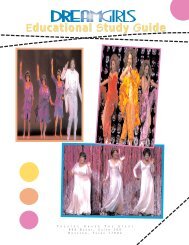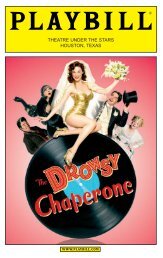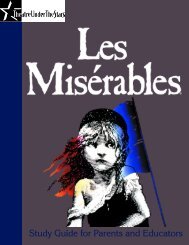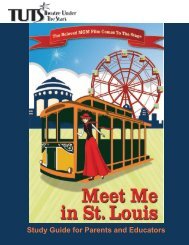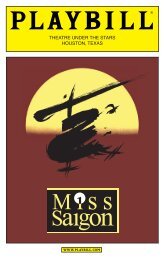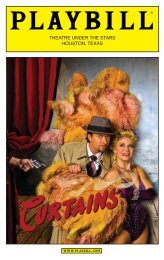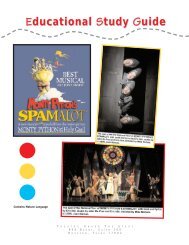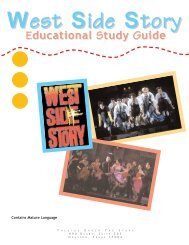The Drowsy Chaperone Study Guide - Theatre Under The Stars
The Drowsy Chaperone Study Guide - Theatre Under The Stars
The Drowsy Chaperone Study Guide - Theatre Under The Stars
Create successful ePaper yourself
Turn your PDF publications into a flip-book with our unique Google optimized e-Paper software.
“Imagine, if you will, it’s November, 1928.<br />
You’ve just arrived at the doors of the<br />
Morosco <strong>The</strong>atre in New York. It doesn’t<br />
exist anymore, it was torn down in 1982,<br />
and replaced with an enormous hotel. It’s<br />
awful. Unforgivable. Anyway, it’s very cold<br />
and a heavy grey sleet is falling from the<br />
sky but you don’t care because you’re going<br />
to see a Broadway show! Listen!”<br />
12<br />
Man in Chair, from <strong>The</strong> <strong>Drowsy</strong> <strong>Chaperone</strong><br />
Sometimes after a great shock or sorrow,<br />
you just want to have a party. That’s what<br />
the 1920s were: one long, fabulous, roaring<br />
party of a decade after years of horror<br />
and war. World War I had brought the<br />
world so much death; tens of thousands of young men had been<br />
lost. <strong>The</strong> old ways of behaving, the old moralities, seemed oldfashioned.<br />
People had had enough of reality – they wanted<br />
spectacle and romance, fun and frivolity. Solemnity and seriousness<br />
were out – fun and spectacle were in. <strong>The</strong> American people<br />
wanted a new way of looking at the world, a new perspective.<br />
And they got it, in their music, their clothes, their architecture, and<br />
especially in their theatre.<br />
Jazz was the soundtrack of this wild new era, and musical theatre<br />
artists did not hesitate to use this uniquely American sound in their<br />
shows. If America broke its political ties with Europe in 1776, it finally<br />
broke away theatrically during the 20s. During the 19th century,<br />
the European operetta had been the model for American theatre,<br />
but, like all of American culture, something new was needed. As<br />
Prince Dorough says in Popular-Music Culture in America, “<strong>The</strong><br />
1920s musicals ...avoided the sentimentality and slightly aristocratic<br />
tone that came from Viennese operetta. American musical<br />
comedies were brassy and brash, lively and spicy, colloquial and<br />
earthy. <strong>The</strong>y employed more of the elements of dance and music<br />
that were identifiably American, and they accurately reflected<br />
the optimism and hedonism, the frenetic energy, and the<br />
abandoned, carefree attitudes of the postwar-boom era.” This is<br />
the joyous passion that <strong>The</strong> <strong>Drowsy</strong> <strong>Chaperone</strong> celebrates.



